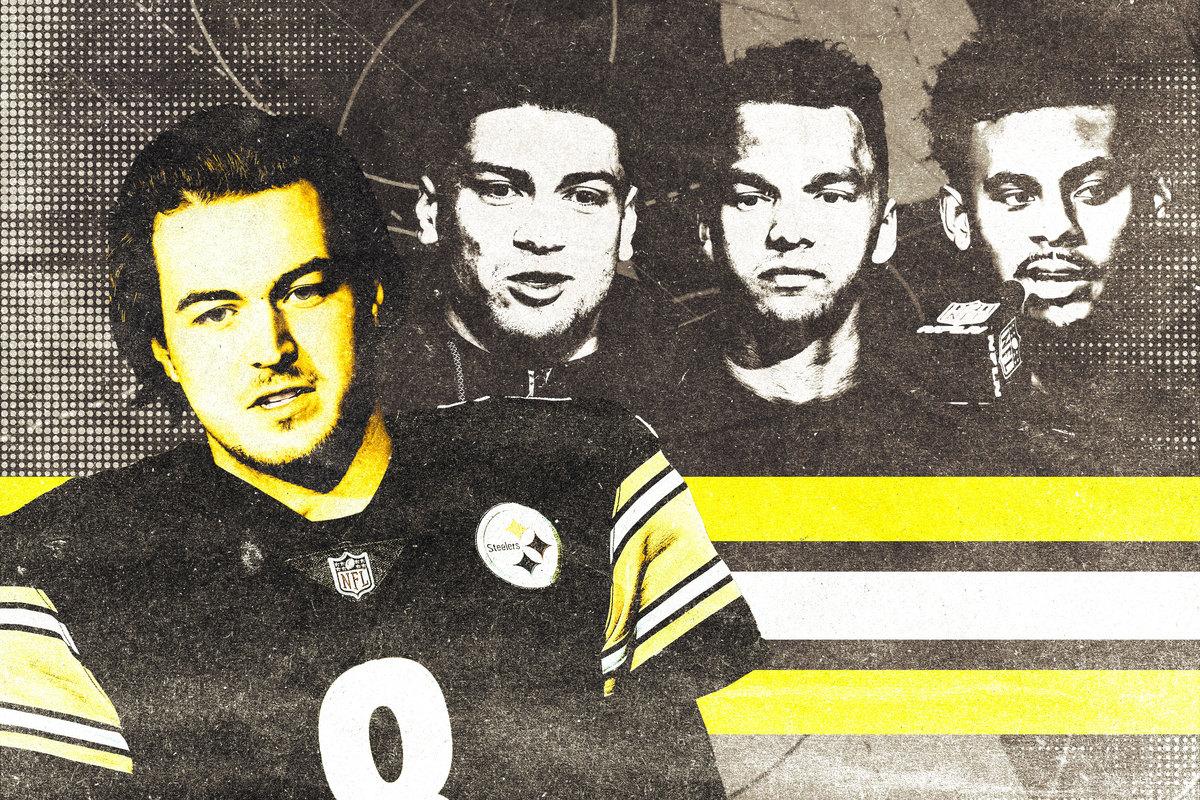NFL Teams Just Showed Us What They Really Think About This QB Class
After months of speculation about how many passers would be taken in the first round of the draft, just one—Kenny Pickett—went off the board Thursday night. What does that mean for the other top prospects? And did the Steelers make the right choice?
The first night of the 2022 NFL draft was predictably unpredictable, but analysts got at least one thing right: teams did not care for this year’s class of quarterbacks. For the first time since 2013, fewer than two quarterbacks were taken in the first round—only Kenny Pickett, who went 20th to the Steelers. And you have to go back 13 more years for the last time we didn’t see one go in the top 17 picks.
Pickett beat out Malik Willis, Desmond Ridder, Matt Corral, and Sam Howell for this year’s title of QB1. And Pittsburgh didn’t have to jump up to get him, either. As teams traded up and down the draft board Thursday night, the Steelers sat back and let Pickett fall to them. There seemingly weren’t any other QB-needy teams to box out. The pick didn’t spark a late-round run on the position. Had Pickett not been the selection there, we might have not seen a quarterback taken on Day 1.
That a soon-to-be 24-year-old with only an OK arm was the first passer off the board tells you everything you need to know about the NFL’s view of this group of prospects. As the primary “pro-ready” QB prospect from this year’s draft, Pickett should compete for the starting job from day one. But there’s a clear ceiling on his game, and he could very well end up being a guy the Steelers ride for the duration of his rookie contract before moving on when he gets expensive. It’s not a bad strategy, nor is it a risky one, which makes the other quarterbacks’ slide out of the first round even more concerning: If any team truly believed that Willis, Ridder, Corral, or Howell were viable long-term starters, they would have jumped back into the first round to pick them and secure the all-important fifth-year option that’s guaranteed on all first-round picks.
Granted, you don’t have to dig too far into the NFL’s history to find examples of Day 2, and even Day 3, quarterbacks who quickly seized control of the keys to the franchise that drafted them—Andy Dalton in Cincinnati, Russell Wilson in Seattle, Derek Carr in Oakland, Dak Prescott in Dallas—but this remaining group of prospects is already facing an uphill battle. While Pickett will likely be given plenty of chances to fail in Pittsburgh, it’s much easier for teams to move on from Day 2 picks who don’t perform right away. And with what looks like a good group of passers entering the league next season, those four will have to impress early if they’re going to convince their new teams to stay out of the 2023 QB market.
Willis should probably be least discouraged by his slide. It was assumed he would have the steepest learning curve, given that he didn’t play quarterback full-time until his senior year of high school, didn’t get his first college start until 2020, and played in a Liberty offense that didn’t utilize many pro-style passing concepts. Compared to the rest of this class, he has a lot of ground to make up.
Malik Willis Hasn’t Played a Lot of Football
He was always going to start his pro career on the bench, where he can learn the intricacies of the position. Now, he’ll just have to fight a bit harder to get off it. And he does have one thing going for him that the other quarterbacks expected to go on Day 2 don’t: His game is objectively fun to watch. The highlight-reel throws and runs he’ll undoubtedly have during camp and preseason will quickly endear him to his new fan base.
Many believe that the best landing spot for Willis is a team that already has a veteran starter. The theory is that the 22-year-old could learn from this hypothetical vet while sitting on the bench—and with the Vikings, Buccaneers, and Titans lurking at the top of the second round (and all three teams likely to move on from their current starters in the next few years) we could see that scenario play out. But I’m not sure that’s what’s best for the Liberty product. You don’t get better at playing football by not playing football. If Willis is going to develop the traits that he never got to develop in school, he’ll have to get as many reps as possible as quickly as possible. Therefore, Willis’s best landing spot might be a place like Washington or Carolina—teams with flawed options at the top of the depth chart that will give him a legitimate shot at sneaking onto the field at some point in 2022, otherwise known as the Jalen Hurts development path.
Ridder is the other prospect we could see play right away. It’s somewhat surprising that he didn’t emerge as this year’s top “pro-ready” prospect. As The Ringer’s Ben Solak wrote this week, he’s the best processor in this draft, and while he was mostly pigeonholed into a game-manager role at Cincinnati, he played aggressively within the framework of the offense. He may not have produced the gaudy numbers we saw out of Pickett last season, but his film is far more impressive and full of plays that will translate to the next level.
Ridder is good at getting rid of the ball quickly, but he’s far from conservative. That’s a rare combination. Most quarterbacks with a low time-to-throw are dumping the ball off to targets running short routes. That wasn’t the case for the four-year starter, who combined his quick release with a high average depth of target, as this chart from Pro Football Focus’s Ben Linsey shows:
Ridder got rid of the ball about a half-second quicker than Pickett did while throwing farther downfield. Per Sports Info Solutions’ “snap-to-throw plus-minus” stat, which compares a passer’s average time-to-throw to their expected time-to-throw based on dropback type, Ridder got rid of the ball 0.12 seconds faster than expected, ranking second in the class. Pickett got rid of the ball 0.14 seconds slower than expected, tied for eighth among this year’s prospects. The evidence overwhelmingly suggests the Steelers passed on the passer who’s actually this year’s most pro-ready quarterback.
The top half of the second round is full of teams that could use a quarterback like Ridder. Seattle has back-to-back picks starting at 40 and has been linked with the 22-year-old throughout the predraft process. If he makes it past the Seahawks, the Falcons have the 43rd pick and could bring him in to compete with presumed starter Marcus Mariota. The Texans can beat both teams to the punch and take him with the 37th pick if they aren’t completely sold on Davis Mills (which they probably shouldn’t be).
Willis and Ridder could still find themselves in good situations, but I’m not sure we can say the same about Howell and Corral. Both are shorter prospects who played in RPO-heavy college offenses that don’t translate to the pros. And neither possesses elite traits like Willis’s arm or mobility. Howell throws a pretty deep ball but can’t drive it as effortlessly as the top throwers in the sport do. Corral can sling it, too, but he’s not overly accurate and doesn’t test tight windows nearly enough. Unless there are some teams that fell in love with either guy during the interview process—which is possible!—these two will likely be drafted as developmental backups who will need some fortunate breaks if they’re ever going to get a real shot at starting.
It’s still far too early to write off any of these prospects—four of them haven’t even been drafted yet—but the NFL has generally been pretty good at identifying which quarterbacks are worthy of a first-round pick. At least in recent years, when nearly all of the quarterbacks who have emerged as bona fide stars were drafted on the first day.
Good quarterback prospects just don’t slip through the cracks as often as they once did. Maybe this group will buck that trend. Maybe Willis will reach his ceiling. Maybe Ridder’s processing will carry him through a long, successful career. Maybe Howell and Corral will prove me wrong and develop into franchise players. They’d just better do it in a hurry.

